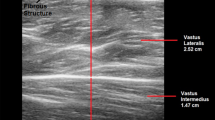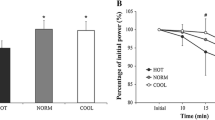Summary
The influence of exercise intensity on thermoregulation was studied in 8 men and 8 women volunteers during three levels of arm-leg exercise (level I: 700 ml oxygen (O2) · min−1; level II: 1250 ml O2 · min−1; level III: 1700 ml O2 · min−1 for 1 h in water at 20 and 28°C (T w). For the men inT w 28°C the rectal temperature (T re) fell 0.79°C (P<0.05) during immersion in both rest and level-I exercise. With level-II exercise a drop inT re of 0.54° C (P < 0.05) was noted, while at level-III exerciseT re did not change from the pre-immersion value. AtT w of 20°C,T re fell throughout immersion with no significant difference in finalT re observed between rest and any exercise level. For the women at rest atT w 28°C,T re fell 0.80°C (P<0.05) below the pre-immersion value. With the two more intense levels of exercise,T re did not decrease during immersion. InT w 20°C, the women maintained higherT re (P<0.05) during level-II and level-III exercise compared to rest and exercise at level I. TheT re responses were related to changes in tissue insulation (I t) between rest and exercise with the largest reductions inI t noted between rest and level-I exercise acrossT w and gender. For men and women of similar percentage body fat, decreases inT re were greater for the women at rest and level-I exercise inT w 20°C (P< 0.05). With more intense exercise, the women maintained a higherT re than the men, especially in the colder water. These findings indicate that exercise is not always effective in offsetting the decrease inI t and facilitated heat loss in cool or cold water compared to rest. The factors of exercise intensity,T W, body fat, and gender influence the thermoregulatory responses.
Similar content being viewed by others
References
Broéek J, Grande F, Anderson JT, Keys A (1963) Densitometric analysis of body composition: revision of some quantitative assumptions. Ann NY Acad Sci 110:113–140
Burton AC (1935) Human calorimetry. II. The average temperature of the tissues of the body. J Nutr 9:261–280
Cannon P, Keatinge WR (1960) The metabolic rate and heat loss of fat and thin men in heat balance in cold and warm water. J Physiol (Lond) 154:321–344
Costill DL, Cahill PJ, Eddy D (1967) Metabolic responses to submaximal exercise in three water temperatures. J Appl Physiol 22:628–632
Craig AB Jr, Dvorak M (1966) Thermal regulation, during water immersion. J Appl Physiol 21:1577–1585
Craig AB Jr, Dvorak M (1968) Thermal regulation of man exercising during water immersion. J Appl Physiol 25:28–35
Craig AB Jr, Dvorak M (1969) Comparison of exercise in air and water of different temperatures. Med Sci Sports 1: 124–130
DuBois D, DuBois EF (1916) Clinical calorimetry. X. A formula to estimate the approximate surface area if height and weight be known. Arch Int Med 17:863–871
Ducharme MB, Tikuises P (1991) In vivo thermal conductivity of the human forearm tissues. J Appl Physiol 70:2682–2690
Edwards DAW (1951) Differences in the distribution of subcutaneous fat with sex and maturity. Clin Sci 10:305–315
Ferretti G, Veicsteinas A, Rennie DW (1988) Regional heat flows of resting and exercising men immersed in cold water. J Appl Physiol 64:1239–1248
Graham TE, Viswanathan M, Van Dijk JP, Bonen A, George JC (1989) Thermal and metabolic responses to cold by men and by eumenorrheic and amenorrheic women. J Appl Physiol 67:282–290
Hayward MG, Keatinge WR (1981) Role of subcutaneous fat and thermoregulatory reflexes in determining ability to stabilize body temperature in water. J Physiol (Loud) 320:229–251
Hayward JS, Eckerson JD, Collis ML (1975a) Effect of behavioral variables on cooling rate of men in cold water. J Appl Physiol 38:1073–1077
Hayward JS, Eckerson JD, Collis ML (1975b) Thermal balance and survival time prediction of man in cold water. Can J Physiol Pharmacol 53:21–32
Holmér I, Bergh V (1974) Metabolic and thermal response to swimming in water at varying temperatures. J Appl Physiol 37:702–705
Keatinge WR (1969) Survival in cold water: the physiology and treatment of immersion hypothermia and drowning. Blackwell, Oxford
McArdle WD, Magel JR, Lesmes GR, Pechar GS (1976) Metabolic and cardiovascular adjustment to work in air and water at 18, 25 and 33°C. J Appl Physiol 40:85–90
McArdle WD, Magel JR, Gergley TJ, Spina RJ, Toner MM (1984a) Thermal adjustment to cold water exposure in resting men and women. J Appl Physiol 56:1565–1571
McArdle WD, Magel JR, Spina RJ, Gergley TJ, Toner MM (1984b) Thermal adjustment to cold water exposure in exercising men and women. J Appl Physiol 56:1572–1577
Nadel ER, Holmér I, Bergh V, Astrand P-O, Stolwijk JAJ (1974) Energy exchange of swimming man. J Appl Physiol 36:465–471
Pandolf KB, Toner MM, McArdle WD, Magel JR, Sawka MN (1987) Influences of body mass morphology and gender on thermal response during immersion in cold water. In: Bove AA, Bachrach AJ, Greenbaum LJ Jr (eds) Underwater and hyperbaric physiology IX. Undersea and Hyperbaric Medical Society, Bethesda, MO, pp 145–152
Pugh LGC, Edholm OG, Fox RH, Wolf HS, Hervey GR, Hammond WH, Tanner JM, Whithehouse RH (1960) A physiological study of channel swimming. J Clin Invest 37:538–547
Sagawa S, Shiarki K, Yousef MK, Konda N (1988) Water temperature and intensity of exercise in maintenance of thermal equilibrium. J Appl Physiol 65:2413–2419
Toner MM, McArdle WD (1988) Physiological adjustments of man to the cold. In: Pandolf KB, Sawka MN, Gonzalez RR (eds) Human performance physiology and environmental medicine at terrestrial extremes Benchmark, Indianapolis, pp 368–378
Toner MM, Sawka MN, Pandolf KB (1984) Thermal responses during arm and leg and combined arm-leg exercise in water. J Appl Physiol 56:1355–1360
Toner MM, Sawka MN, Holden WL, Pandolf KB (1985) Comparison of thermal responses between rest and leg exercise in water. J Appl Physiol 49:248–253
Veicsteinas A, Ferretti G, Rennie DW (1982) Superficial shell insulation in resting and exercising men in cold water. J Appl Physiol 52:1557–1564
Wilmore JH (1969) A simplified method for determination of residual lung volumes. J Appl Physiol 27:96–100
Witherspoon JM, Goldman RF, Breckenridge JR (1970) Heat transfer coefficients of humans in cold water. J Physiol (Paris) 63:459–462
Author information
Authors and Affiliations
Rights and permissions
About this article
Cite this article
McArdle, W.D., Toner, M.M., Magel, J.R. et al. Thermal responses of men and women during cold-water immersion: influence of exercise intensity. Europ. J. Appl. Physiol. 65, 265–270 (1992). https://doi.org/10.1007/BF00705092
Accepted:
Issue Date:
DOI: https://doi.org/10.1007/BF00705092




